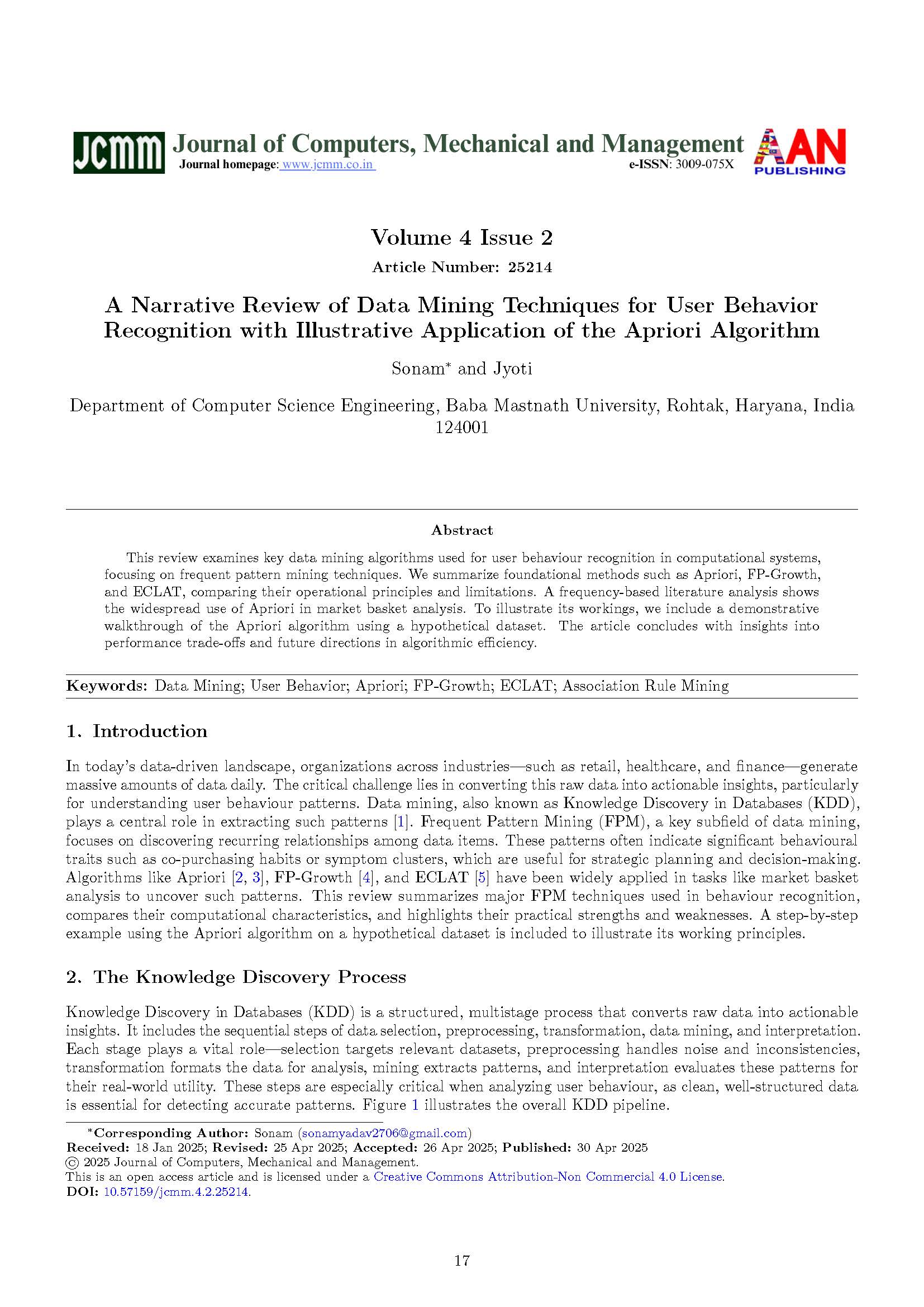A Narrative Review of Data Mining Techniques for User Behaviour Recognition with Illustrative Application of the Apriori Algorithm
DOI:
https://doi.org/10.57159/jcmm.4.2.25214Keywords:
Data Mining, User Behavior, Apriori, FP-Growth, ECLAT, Association Rule MiningAbstract
This review examines key data mining algorithms used for user behaviour recognition in computational systems, focusing on frequent pattern mining techniques. We summarize foundational methods such as Apriori, FP-Growth, and ECLAT, comparing their operational principles and limitations. A frequency-based literature analysis shows the widespread use of Apriori in market basket analysis. To illustrate its workings, we include a demonstrative walkthrough of the Apriori algorithm using a hypothetical dataset. The article concludes with insights into performance trade-offs and future directions in algorithmic efficiency.
References
R. Shukla and A. K. Solanki, “Performance analysis of frequent pattern mining algorithm using Apriori on medical data,” International Research Journal of Computer Science (IRJCS), vol. 2, no. 10, 2015.
J. Jha and L. Ragha, “Educational data mining using improved Apriori algorithm,” International Journal of Information and Computation Technology, vol. 3, no. 5, 2013.
P. Tanna and Y. Ghodasara, “Using Apriori with Weka for Frequent Pattern Mining,” International Journal of Engineering Trends and Technology (IJETT), vol. 12, no. 3, 2014.
P. Prithiviraj and R. Porkodi, “A comparative analysis of association rule mining algorithms in data mining: A study,” American Journal of Computer Science and Engineering Survey, vol. 3, no. 1, pp. 98–119, 2015.
Z. Farzanyar and N. Cercone, “Efficient mining of frequent itemsets in social network data based on mapreduce framework,” in Proc. IEEE/ACM International Conference on Advances in Social Networks Analysis and Mining (ASONAM), pp. 1183–1188, 2013.
DataFlair, “Data mining architecture - components, types & working.” Available: https://data-flair.training/blogs/data-mining-architecture/
R. Karthiyayini and J. Jayaprakash, “Association technique on prediction of chronic diseases using apriori algorithm,” International Journal of Innovative Research in Science, Engineering and Technology, vol. 4, Special Issue 6, May 2015.
K. Geetha and S. K. Mohiddin, “An efficient data mining technique for generating frequent itemsets,” International Journal of Advanced Research in Computer Science and Software Engineering, vol. 3, no. 4, pp. 571–575, 2013.
A. Imran and P. Ranjan, “Improved Apriori algorithm using power set on Hadoop,” in Proc. 1st International Conference on Computational Intelligence and Informatics, Hyderabad, India, pp. 245–254, 2017.
N. Ur-Rahman, “Textual data mining for knowledge discovery and data classification: A comparative study,” European Scientific Journal, vol. 13, no. 21, 2017.
M. Dhanya, M. Vysaakan, and A. Mahesh, “An enhancement of the MapReduce Apriori algorithm using vertical data layout and set theory concept of intersection,” in Intelligent Systems Technologies and Applications, vol. 385, pp. 225–233, 2016.
C. Kaur, “Association rule mining using apriori algorithm: A survey,” International Journal of Advanced Research in Computer Engineering & Technology (IJARCET), vol. 2, no. 6, 2013.
Y. Rochd and I. Hafidi, “An enhanced apriori algorithm using hybrid data layout based on Hadoop for big data processing,” International Journal of Computer Science and Network Security (IJCSNS), vol. 18, no. 6, 2018.

Downloads
Published
How to Cite
License
Copyright (c) 2025 Journal of Computers, Mechanical and Management

This work is licensed under a Creative Commons Attribution-NonCommercial 4.0 International License.
The Journal of Computers, Mechanical and Management applies the CC Attribution- Non-Commercial 4.0 International License to its published articles. While retaining copyright ownership of the content, the journal permits activities such as downloading, reusing, reprinting, modifying, distributing, and copying of the articles, as long as the original authors and source are appropriately cited. Proper attribution is ensured by citing the original publication.





